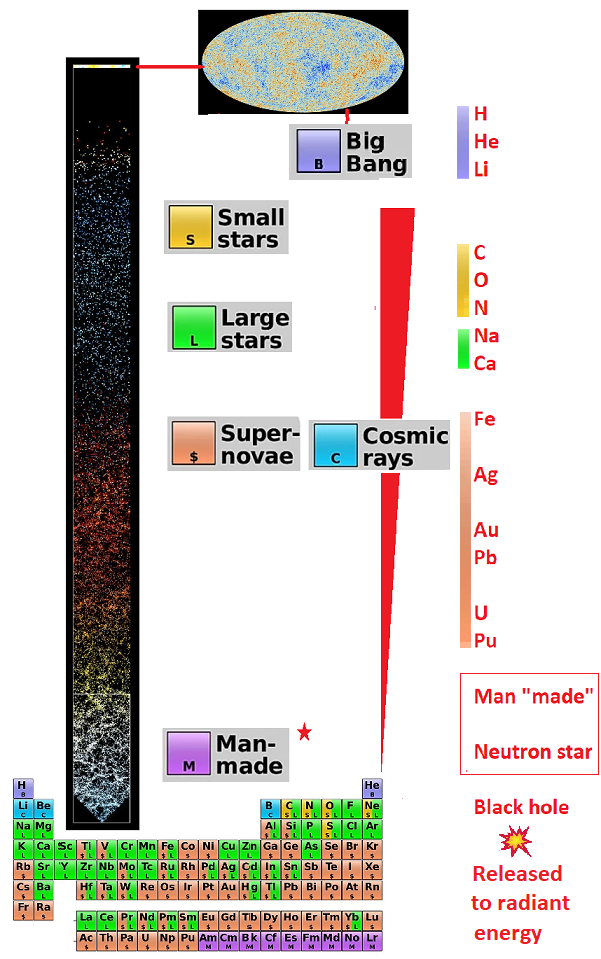Further observations about physics – split files
(22)Creating the elements of the universe
There are a couple of useful websites from which I have constructed this diagram. They are listed at the end of this section.
First, some explanation: the bar on the left is taken from the first site and shows the progression of the most distant parishes of the universe to the closest parishes. Quite surprisingly, the impression given (and it seems to be real) is that we are surrounded by the Cosmic Microwave Background Radiation (CMBR) at the very edge of our "visible" universe. Now, if this is real (and why should it not be?) then there is an "instant" of intense inflation (but not as classically interpreted). Now, that sits very well with the deductions in (20) Construction from magnetic bubbles. The SoL limit applies to all interacting particles on the universe side but not through the wormhole tunnel. So that looks like it is possible for the whole of the swallowed baryonic matter that enters a black hole to be "shredded" back to photonic energy, then "radiated out/released/disentangled" to join the surrounding CMBR. The passage of time at both the crossover (across the event hirizon) and at the extreme of the magnetic bubble expansion are "all location" and "no passage of time". They are, effectively, outside of our imagined temporal constraints on how long it would take for Hawking radiation to evaporate a black hole; and it is also outside the imagined temporal constraints for a trip along the wormhole tunnel that stretches from a black hole to that CMBR. We imagine that the black hole image and the CMBR are apparently more that 14 bn light years apart. That distance may not be constrained by the Maxwellian velocity limit of interacting particles on the universe side (vs the antiverse side - that should have its own similar constraint).

So, the CMBR (probably in the form of a Bose-Einstein condensate), effectively, rains down on us a shower of electron-positron pairs that are (somehow) separated/rectified in this parish. These slowly condense by forming all the nuclear components to make simple hydrogen and helium. Then there is a production line of progressively "winding up" photonic energy into more and more complex particles (then atoms). I am not sure of the correctness of where I have placed the coloured "generation" boxes; this order seems to make sense to me. Note why I have starred "Man-made". This is to indicate that – in our parish – these heavy elements are very unstable and their entropic decay is back towards iron (Fe). Fe seems to be our entropic high spot – we can (with difficulty) overcome the rectification "force" that resists our attempts to fuse hydrogen atoms into heavier atoms and we can split heavier elements back down towards iron. But Fe will render no energy source. Both of these manoevres spill a large flux of photons because of the inefficiency of the procedure that allows some matter to completely unwind back into photons. These ultraheavy and unstable elements probably have their own parish of stability (deep inside a large star or on the way to becoming a neutron star).
And: on the subject of a neutron star, here is the most profound and intense "winding up" of photons that can (apparently) occur. These are made of an "up" quark (+2/3 charge) and two "down" quarks (-1/3 charge). My conjecture is that this is formed by two free electrons (possibly close to the universe entry point of the wormhole-entanglement-tunnel and a pair of orbital positrons (close to the antiversal end of the tunnel). It is hard to imagine how a more compact object could be made.
[A couple of extra thinks:– this gives meaning to the r to 1/r transition that string theorists talk of; it also gives meaning to the idea that light does not experience the passage of time.]